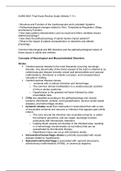Other
NURS 6501 / NURS6501: Advanced Pathophysiology
• Structure and Function of the Cardiovascular and Lymphatic Systems • Pathophysiological changes related to Pain, Temperature Regulation, Sleep, and Sensory Function • How does patient characteristics such as racial and ethnic variables impact altered physiology? • How does the pathop...
[Show more]



